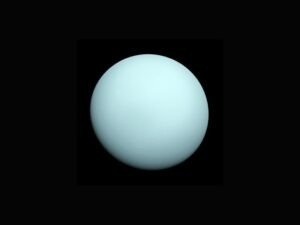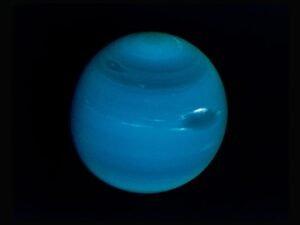Ganymede is the largest moon in the solar system and is even larger than the planet Mercury. It is one of Jupiter’s 79 known moons and was discovered by Galileo Galilei in 1610. Ganymede is named after the mythological cupbearer of the Greek gods and is a fascinating celestial body that has captured the attention of astronomers and space enthusiasts alike. It is a unique moon with a complex and diverse geological history, making it a subject of great interest for scientists studying the outer solar system.
Ganymede is a part of the Galilean moons, which also include Io, Europa, and Callisto. It is the only moon in the solar system known to have its own magnetic field, which is believed to be generated by a liquid iron core. This magnetic field is thought to be responsible for the creation of auroras on Ganymede, making it an even more intriguing object of study. With its icy surface and subsurface ocean, Ganymede has the potential to harbor life, making it a prime target for future exploration missions. In this article, we will delve into the geological features, surface composition, atmosphere, magnetic field, potential for life, and exploration missions to Ganymede, as well as the future prospects for studying this enigmatic moon.
Key Takeaways
- Ganymede is the largest moon in the solar system and is even larger than the planet Mercury.
- The geological features of Ganymede include grooved terrain, impact craters, and tectonic faults.
- Ganymede’s surface composition is primarily made up of water ice and silicate rock, and it has a very thin atmosphere.
- Ganymede has a weak magnetic field and exhibits auroras at its poles.
- There is potential for life on Ganymede due to its subsurface ocean and the presence of organic molecules.
- Exploration missions to Ganymede, such as the upcoming JUICE mission by the European Space Agency, aim to study the moon’s composition and potential habitability.
- Future prospects for studying Ganymede include further exploration missions and the potential discovery of life in its subsurface ocean.
Geological features of Ganymede
Ganymede’s surface is a fascinating blend of different geological features that provide valuable insights into its history and formation. The moon’s surface is divided into two main types of terrain: the darker regions, which are heavily cratered and ancient, and the lighter regions, which are younger and have fewer impact craters. The darker regions are believed to be composed of older, more heavily processed ice, while the lighter regions are thought to be made up of fresher ice that has been resurfaced by tectonic processes.
One of the most prominent features on Ganymede is its grooved terrain, which consists of long, linear ridges and valleys that crisscross the moon’s surface. These grooves are believed to be the result of tectonic forces that have caused the crust to stretch and pull apart, creating the distinctive patterns that we see today. In addition to the grooved terrain, Ganymede also has impact craters of various sizes, some of which have been partially erased by tectonic activity. These craters provide important clues about the age and history of the moon’s surface, as well as the frequency of impact events in the outer solar system. Overall, Ganymede’s geological features paint a complex picture of a moon that has been shaped by a variety of processes over billions of years.
Surface composition and atmosphere
Ganymede’s surface is primarily composed of water ice, with some rocky materials mixed in. The moon’s icy surface gives it a bright and reflective appearance, making it one of the brightest objects in the solar system. In addition to water ice, Ganymede’s surface also contains various compounds such as sulfur dioxide and carbon dioxide, which contribute to its unique coloration and composition. The presence of these compounds suggests that Ganymede’s surface has been altered by processes such as sublimation and radiation from Jupiter’s magnetosphere.
Ganymede has a very thin atmosphere, composed mainly of oxygen. This tenuous atmosphere is thought to be produced by the interaction of charged particles from Jupiter’s magnetosphere with the moon’s surface ice. Despite its thinness, Ganymede’s atmosphere plays a crucial role in shaping its surface through processes such as sputtering and sputter erosion. The presence of an atmosphere also raises intriguing questions about the potential for habitability on Ganymede, as it could provide a source of oxygen for potential life forms in the subsurface ocean.
Magnetic field and auroras
| Metrics | Explanation |
|---|---|
| Magnetic Field Strength | The intensity of the magnetic field at a specific location, measured in teslas (T). |
| Aurora Borealis | The northern lights, a natural light display in the Earth’s sky, predominantly seen in high-latitude regions. |
| Aurora Australis | The southern lights, similar to the Aurora Borealis but seen in the southern hemisphere. |
| Solar Wind | A stream of charged particles released from the upper atmosphere of the sun, which interacts with the Earth’s magnetic field and can cause auroras. |
Ganymede is the only moon in the solar system known to have its own magnetic field, which is believed to be generated by a liquid iron core. This magnetic field is unique among moons and is thought to be a result of the moon’s large size and internal structure. The presence of a magnetic field has important implications for Ganymede’s geology and potential for habitability, as it can shield the moon’s surface from harmful radiation and influence its interaction with Jupiter’s magnetosphere.
The interaction between Ganymede’s magnetic field and Jupiter’s powerful magnetosphere leads to the creation of auroras on the moon’s surface. These auroras are similar to Earth’s northern and southern lights and are produced when charged particles from Jupiter’s magnetosphere collide with Ganymede’s atmosphere. Studying these auroras can provide valuable insights into the composition and dynamics of Ganymede’s atmosphere, as well as its interaction with Jupiter’s magnetosphere. The presence of auroras on Ganymede further highlights its status as a unique and dynamic world within the outer solar system.
Potential for life on Ganymede
Ganymede’s subsurface ocean is one of its most intriguing features and has led to speculation about the potential for life on the moon. The existence of a subsurface ocean was confirmed by data from the Galileo spacecraft, which detected a magnetic field that is likely generated by a salty ocean beneath the icy crust. This subsurface ocean is thought to be in contact with the rocky mantle below, providing a source of heat and chemical nutrients that could support microbial life.
The presence of an atmosphere on Ganymede further enhances its potential for habitability, as it could provide a source of oxygen for potential life forms in the subsurface ocean. The combination of liquid water, heat, and chemical energy makes Ganymede an exciting target for astrobiological research and has sparked interest in future exploration missions to search for signs of life on the moon. While there is currently no direct evidence of life on Ganymede, its unique combination of geological features and potential habitable conditions make it an enticing destination for future study.
Exploration missions to Ganymede

Several spacecraft have visited or flown by Ganymede, providing valuable data about its surface and composition. The Galileo spacecraft, launched by NASA in 1989, conducted multiple flybys of Ganymede and provided detailed images and measurements of its surface features. These data have been crucial in shaping our understanding of Ganymede’s geology, composition, and potential for habitability.
In addition to past missions, there are several upcoming exploration missions that will focus on studying Ganymede in more detail. NASA’s Europa Clipper mission, scheduled for launch in the 2020s, will conduct multiple flybys of Ganymede to study its surface composition, geology, and potential habitability. The European Space Agency’s JUpiter ICy moons Explorer (JUICE) mission, set to launch in 2022, will also include multiple flybys of Ganymede to study its surface and subsurface ocean. These upcoming missions hold great promise for advancing our understanding of Ganymede and could provide important insights into its potential for hosting life.
Future prospects for studying Ganymede
As technology continues to advance, there are exciting prospects for studying Ganymede in even greater detail in the future. Future missions could include landers or rovers that could explore the moon’s surface up close and collect samples for analysis. In addition to robotic missions, there is also growing interest in potential crewed missions to explore Ganymede and other moons in the outer solar system.
Advancements in space exploration technology could also lead to new discoveries about Ganymede’s geology, composition, and potential for habitability. With ongoing efforts to explore the outer solar system, including planned missions to Europa and other icy moons, there is great potential for furthering our understanding of Ganymede and unlocking its many mysteries.
In conclusion, Ganymede is a fascinating world with a complex geological history and potential for hosting life. Its unique combination of geological features, subsurface ocean, magnetic field, and potential habitable conditions make it an enticing target for future exploration missions. With upcoming missions set to study Ganymede in more detail than ever before, there are great prospects for advancing our understanding of this enigmatic moon and uncovering its many secrets. As technology continues to advance, there is great potential for new discoveries about Ganymede that could revolutionize our understanding of planetary science and astrobiology in the outer solar system.
Discover more about the fascinating world of space exploration and the latest discoveries about Ganymede moon in our related article “Iconic ‘Starsky & Hutch’ Star David Soul, Sioux Falls Native, Passes Away at 80”. Explore the wonders of the universe and stay updated on the latest news and developments.




















+ There are no comments
Add yours